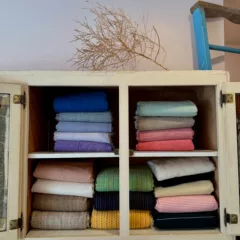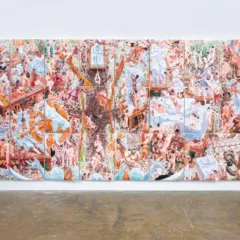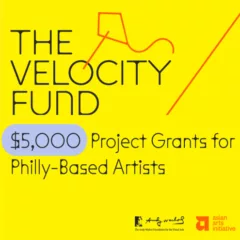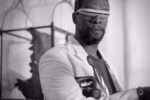The chicken was a thing of beauty with a long speckled neck and banded body. She settled next to a small cement mountain. A blue neon light served as a negative sun. A photographer, Mike Kopena, there to document the installation, walked away from his tripod to the other end of the room to alert the two artists: The chicken had dropped a load on the floor–and was sitting in it. Aargh.
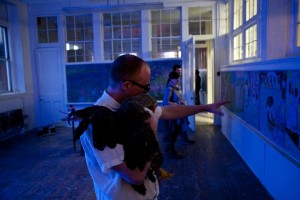
The collaborating artists, Jacque Liu and Mike Ellyson, were two of 10 artists invited to create temporary installations at the Old School Studios, the Crane Art Center’s newest project. The event served as an inaugural celebration of the opening of the building. The rooms, most of which used to be classrooms, are slated for occupancy in May, mostly as studios. In the interim, on a warm spring Second Thursday night (April 14), the pop-up invitational exhibit–Experiential, Environmental, Educational–popped with the two-fold excitement of both the art and the promise of the Crane’s expansion.
Getting back to the chicken, Ellyson (one of the Grizzly Grizzlies) and Liu seemed unperturbed. A few minutes later, Ellyson, dressed in white, paused from reading his Bible, gamely scooped up the chicken, and began teaching a Bible lesson in chicken-squawk-ese.
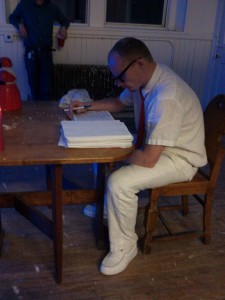
The installation, which is timely and layered, is called An Education with Congressman John Lewis. Lewis, who as a child preached to the chickens in the chicken yard, had this to say about the House Republicans (see full quote on Daily Kos):
I’m convinced that some of those chickens that I preached to in the 40s and the 50s tended to listen to me much better than some of my Republican colleagues listen to us in the Congress today…I think some of those chickens were probably a little more productive. At least they produced eggs!
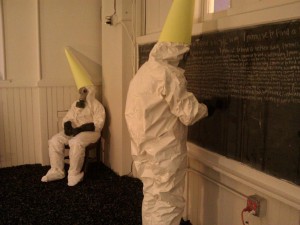
The show was curated by Jerry Kaba, who included a swell installation of his own. Kaba’s centerpiece was a cooling tower form from floor almost to the ceiling, emitting flashing beams of light along with sirens that cycled on and off, bleeding into all the other installations (the one that suffered most was Katya Gorker’s video in the next classroom). Kaba’s floor of chipped tires created a no-man’s-land disaster zone even though it was fun and springy to walk on. A pair of facility workers in white hazard suits, gas masks and dunce caps wrote their lesson–“I promise to find a better way.”–a kajillion times on the blackboard.
The topicality of the nuclear meltdown turned out to be a double-edged sword–providing delight for relevance to current events, but at the same time overwhelming the nuances of the piece.
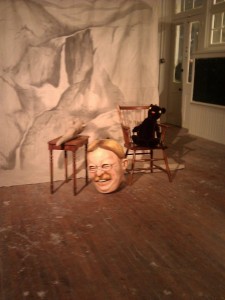
Artist Ryan W. Kelly looked like a bobble-head doll, wearing a giant Teddy Roosevelt head and holding a teddy bear in front of what I took to be a national park scene on a stage backdrop. I loved the theatricality of the props and costume creating a scene in the country, and the scale shift of head to body.
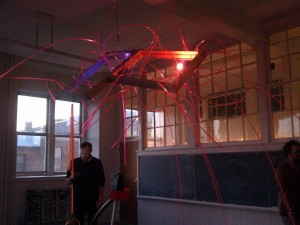
The three pieces were a nice sample of the kind of performances that have been increasingly shown in Philadelphia’s off-the-grid galleries. I’m thinking of works I’ve seen at Extra Extra, Bodega and Little Berlin for example. Tim Eads’ slot machine economy flow-chart gizmo seemed somehow of a different ilk. It was not so much a performance but an interactive piece. When I stood frozen before his toy slot machine (I really dislike gambling), Tim must have sensed my distress and kindly gave me some coins to put in the slot. I lost it all, but then discovered the machine spun without money added. (Tim said I wasn’t supposed to discover that. So now I’m feeling really lucky, as if I won a secret). This piece was rich with content about life and risks and of course money, needing it, recycling it, grabbing it. The visuals could have been a little stronger, but the ideas were pretty great and seemingly limitless.
Afterwards I bumped into artist Nancy Agati happy to be carrying a tree branch with flower souvenir she took from Joanie Turbek’s porcelain tree installation (taking was encouraged). Others with installations were: C. Pazia Mannella, Daniel Ostrov, and Jessie Hemmons.
To view by appointment, contact Kaba at jerrykaba@gmail.com. But the show is best served by having seen the performances, and not just the installations.


